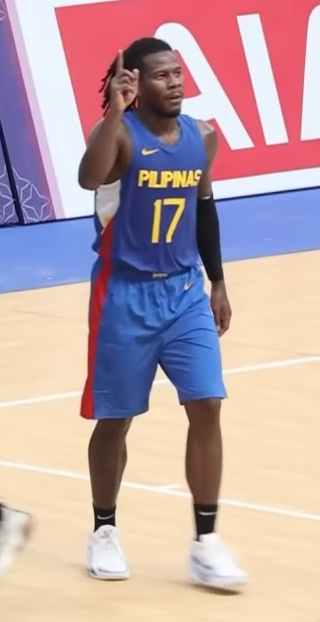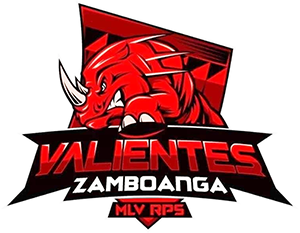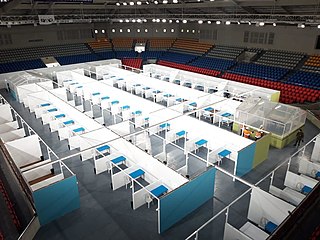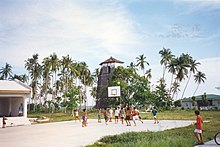
The Philippine Basketball Association (PBA) is a men's professional basketball league in the Philippines composed of twelve company-branded franchised teams. Founded in 1975, it is the first professional basketball league in Asia and is the second-oldest continuously operating professional basketball league in the world after North America's NBA.
The Philippines men's national basketball team, commonly known as Gilas Pilipinas, is the basketball team representing the Philippines. The team is managed by the Samahang Basketbol ng Pilipinas.

Carlos "Caloy" LoyzagayMatute was a Filipino basketball player, coach and politician. He was the most dominant basketball player of his era in the Philippines and is considered as the greatest Filipino basketball player of all time. Loyzaga was a two-time Olympian, as a member of the Philippine national team.

Vincent "Chot" P. Reyes is a Filipino basketball coach who is the head coach for the TNT Tropang Giga of the Philippine Basketball Association (PBA). He also served as the head coach for the Philippine national basketball team, where he led the team to a historic silver medal finish at the 2013 FIBA Asia Championship and its subsequent appearance at the 2014 FIBA World Cup; the country's first in 36 years. He also coached the team in the 2023 FIBA World Cup.

One Sports, currently rebranding to Sports5, is the sports division of TV5 Network, Inc. and jointly-operated with sister company Cignal TV. One Sports supplies and airs major sporting events in the Philippines and the world for free-to-air TV channels TV5, RPTV, One Sports channel, Cignal-exclusive channels One Sports+, PBA Rush, NBA TV Philippines and UAAP Varsity Channel, and online esports streaming channel GG Network.

Dionisio "Chito" Calvo was a Filipino basketball player, swimmer, and coach who mentored both the basketball and football national teams of the Philippines. He was one of the greatest Filipino sportsmen in history and helped in the development of both Philippine and Asian basketball.
Lauro "The Fox" Mumar was a Filipino basketball player and later served as the national team head coach of India and the Philippines. He was one of the greatest Filipino players of his time, playing alongside compatriot legend Carlos Loyzaga. He is the father of Lawrence "Larry" Mumar who was also a basketball player. He is the grandfather of L. A. Mumar, Vico Sotto's half-brother.

The Philippines women's national basketball team is managed by the Samahang Basketbol ng Pilipinas (SBP).
Frederick "Eric" Altamirano is a former Filipino basketball player and he formerly the assistant coach of the Alaska Aces. At the present, he is the commissioner of Chooks-to-Go Pilipinas 3x3 and PBA 3x3. He was part of the Philippine national team that played at the 1986 Asian Games. He is the former head coach of the National University Bulldogs from 2011 to 2016.

Kiefer Isaac Crisologo Ravena is a Filipino professional basketball player for Shiga Lakes of the B2 League. Ravena played for the Ateneo Blue Eagles of the UAAP during his college days. He plays the point guard position.

Ricardo "JR" Cawaling Jr. is a Filipino professional basketball player for Zamboanga Valientes of the ASEAN Basketball League (ABL). He was drafted 30th overall by the San Mig Coffee Mixers in the 2013 PBA draft.

The Philippines men's national 3x3 team represents the country in international 3x3 basketball matches and is governed by the Samahang Basketbol ng Pilipinas.
Christopher Joyce Fernando Javier is a Filipino professional basketball player for the San Juan Knights of the Maharlika Pilipinas Basketball League (MPBL). He was drafted 5th overall by Star in the 2016 PBA draft.
The women's national 3x3 team of the Philippines represents the country in international 3x3 basketball matches and is controlled by the Samahang Basketbol ng Pilipinas.

Christian Jaymar Perez is a Hong Kong-born Filipino professional basketball player for the San Miguel Beermen of the Philippine Basketball Association (PBA). He was selected 1st overall in the 2018 PBA draft by Columbian Dyip.

The Zamboanga Valientes are a Filipino professional basketball team based in the Zamboanga Peninsula. The team has competed in numerous leagues since its founding in 2006, most recently in the Pilipinas VisMin Super Cup during the 2023 Fiesta Pilar Philippines Championship.
The following is a list of notable events and developments that are related to Philippine sports in 2019.

The COVID-19 pandemic had a significant impact on the conduct of sports in the Philippines affecting both competitive sports leagues and tournaments and recreational sports.

PBA 3x3 is the men's 3x3 basketball league of the Philippine Basketball Association (PBA).
The Philippines men's national basketball team won the bronze medal at the 1954 FIBA World Championship held in Brazil. Since the 2014, the event is known as the FIBA Basketball World Cup. This is also the Philippines' first appearance in the tournament.



















